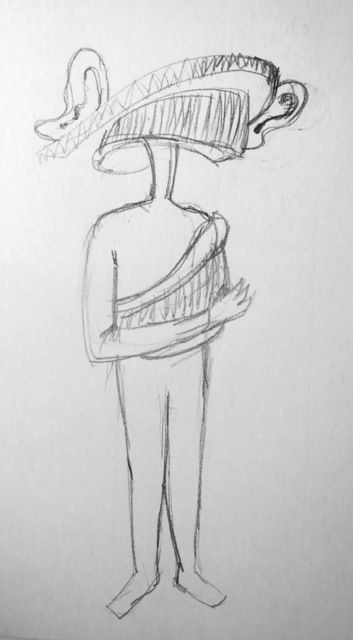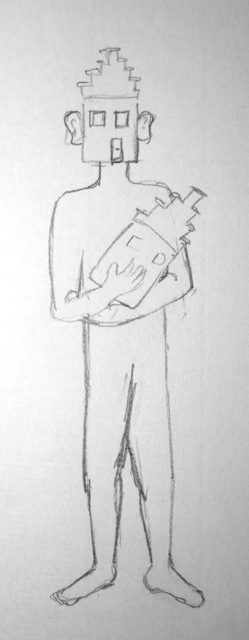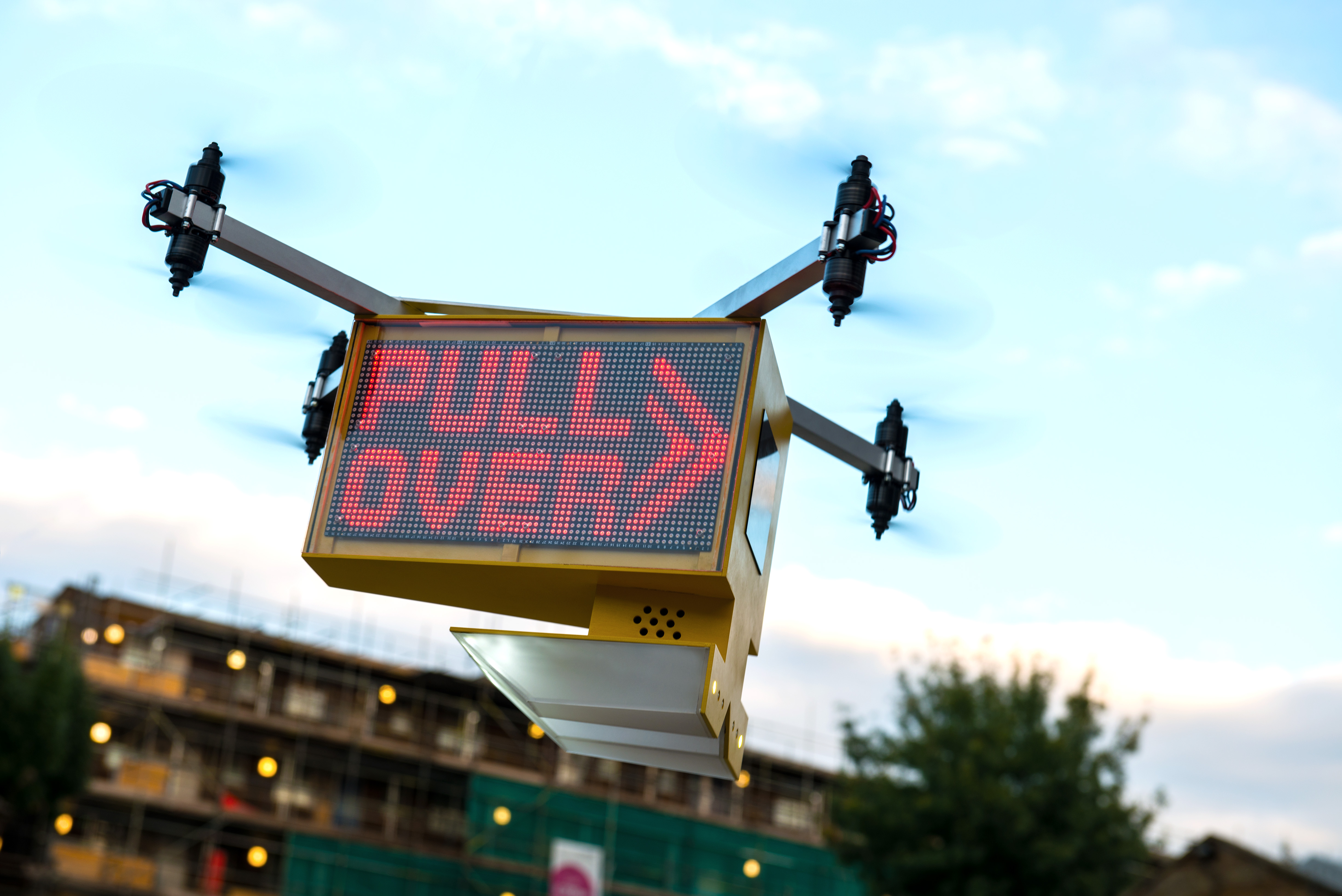Introduction and background of the project
reDesigning Affect Space was an extended art and design, practice and theory project building on the outcomes of the Technology / Affect / Space public research trajectory of Open! Platform for Art, Culture, and the Public Domain, which was conducted with the MIT ACT – Art, Culture, and Technology program in Cambridge (Mass.), the Lectorate for Art and Public Space (LAPS) Rietveld Academy in Amsterdam, and Het Nieuwe Instituut in Rotterdam. The trajectory included public workshops / debates in Cambridge (Mass.), Berlin, Madrid, Amsterdam and Rotterdam.

Image: JARD, Madrid.
Following these workshops six authors have been commissioned to contribute essays and audiovisual works, which were published in sequence on the Open! online publication platform in 2017: Architects Javier Argota and Rodrigo Delso (JARD, Madrid), artist and activist Alessandra Renzi, performance artist and researcher Sher Doruff, and artist duo Esther Polak and Ivar van Bekkum.
In addition to these commissioned contributions Eric Kluitenberg, acting as lead-researcher on this project, wrote a new essay that brings together the outcomes of these workshops and previous investigations in a preliminary description of a conceptual model of Affect Space (explained in brief below). In the reDesigning Affect Space project we wanted to address this conceptual model and the outcomes of our previous public research trajectory to a series of distinguished practitioners in the fields of architecture, design, art, urbanism and digital media to translate these insights into actual (design-) practices.
This was accomplished by organising a series of master classes in Berlin, Madrid and Rotterdam with our international partners, where expert designers, artists, architects, urbanists were exchanged between the participating cities / regions. The master classes involved primarily young professionals and advanced (Master-level) students, and resulted in a series of small scale public interventions into local public spaces. These interventions have been documented, and the outcomes of the master classes and the interventions, including the documentation, provided the basis for a series of public presentations where the results are put up for debate for a broader audience.
We thus aimed to stimulate a lively international exchange between makers / practitioners and generate relevant feedback from theorists and researchers in these fields. The public presentations were organised to involve a wider culturally interested audience in this investigation and stimulate public debate.
The concept of Affect Space deals with the overlap of urban public spaces, the explosive growth of mobile media and wireless networks, and the intense affective exchanges that increasingly dominate how these spaces function, in contrast to the conventional more utilitarian and deliberative functions and uses of public (urban) space. We believe that the dynamics unfolding here require an urgent critical engagement, particularly from the (spatial) design disciplines that traditionally address the functions and design of public spaces. However, these design disciplines are currently notably absent in this domain.
Conceptual model and context
The concept of Affect Space was first proposed in a long-read essay for the Open! platform written and published in 2015 (Kluitenberg, 2015). In this essay the contours of a model were suggested that builds on three constitutive elements:
• A technological component: Interconnected communication networks, in particular internet, mobile media and wireless networks perform a crucial function to mobilise large groups of people around ever changing ‘issues at stake’.
• An affective component: A recurrent characteristic is the affective intensity generated and exchanged in these mobilisation / activation processes in overlapping mediated and urban public spaces — instantiated in the body of the physical actors at the screens and in the streets. Reasoned arguments seem to play much less of a role here than affective images, aphoristic and suggestive slogans and embodied collective rituals.
• A spatial component: The affective intensities generated in the activation process cannot be shared effectively in disembodied online interactions at the screen. This lack stimulates the desire for physical encounter, which can only happen in a physical spatial context — paradigmatically in (urban) public space, where mobile media then feed the action in the streets immediately back into the media networks.
The basic model of Affect Space revealed itself most clearly in the often confusing massive protest gatherings and public space occupations around the globe after 2011. What we observed was that while the specific socio-economic, cultural, and religious context in which these gatherings unfolded was radically different from site to site, the pattern of mobilisation and public gathering remained remarkably constant. Resulting in a puzzling split between content and form.
The model of Affect Space is in no way limited to such protest gatherings. Much rather a new set of functions of overlapping media- and public spaces were revealed by them. Most confusing about these new types of gatherings is that they appear – often quite suddenly – in vastly different spaces, across an enormous variety of geographic, demographic, cultural and political contexts. Meanwhile they remain uncannily consistent in their pattern of mobilisation / activation: Mobilisations start online, expand exponentially, and subsequently spill over into embodied public spaces in an apparent drive to find connection ‘beyond the screen’. The massive presence of mobile media and wireless networks in these public spaces triggers a feedback-loop back into the (networked / social) media network, drawing in an ever larger constituency, while the gatherings themselves are increasingly galvanised by a deep affective intensity.
The Affective Threshold
What we have found, also in our public research, is that the extreme ‘densification’ of overlapping (embodied) urban and (wireless) networked spaces brings about this shift from the deliberative functions of public space / gatherings to primarily affect-driven exchanges. The more dense the connections between the mediated and the embodied, the more these gatherings become dominated by affective exchanges that tend to wash out ideological differences and create highly unstable (temporary) public formations. The dynamics of public space become extremely unpredictable once they start to operate under this primacy of affect. Importantly, though, while this new dynamic is highly unpredictable, it is in no way arbitrary and it is highly susceptible to manipulation.
Crucial to recognise is also that the emergent spatial order of Affect Space is already in full operation. It operates in the new forms of public assembly and their often contradictory dynamics. It also operates in new forms of distributed affective policing and control in and of public space. It is part of a highly evolved system of technologically enabled ‘persuasion design’ (seductive mobile and wearable media, apps and online platforms). Yet, the ‘development-agenda is almost entirely dominated by technological, economic, and security-centric concerns. The spatial design disciplines are notably absent in the debate how to shape and re-/design Affect Space.
Main question: Who has agency in Affect Space?
The main question that guides this project and our search for a more diversified design-agenda for the context of Affect Space is: Who has agency in this context? And what type of ‘designed interventions’ are required to distribute agency (the ability to act effectively) more equitable across the different actors operating in this space — citizens, corporations, public agencies, ‘creatives’, civic organisations, local, national, and transnational authorities ?
The aim of the project was to develop a more diversified design-agenda for the context of Affect Space that transcends current security and safety-driven initiatives and overly technology-centric ‘smart city’ discourses. Our research has shown that the concept of Affect Space is much more than an abstract idea or a purely speculative model. We see powerful actors at work in the context of Affect Space. And while the dynamics of Affect Space are unpredictable, they are also highly sensitive to manipulation. Therefore, an urgent need exists to engage the spatial design disciplines much more actively in this context.
We started out with a series of questions; While the dominant forms of ‘persuasion design’ aim to continuously heat up the affective intensity of mediated exchanges (esp. social media platforms and apps), can designers and artists come up with designs that can ‘cool down’ these exchanges, and allow for different, more deliberative forms of exchange and sociality? If the focus in technology and policy shifts towards non-conscious and collective behaviour in public space, how can we develop inclusive, ‘participatory’ design strategies for Affect Space? Architect and eminent theorist Paul Virilio raised the intriguing question, why is it that technology always speeds processes up, thus eliminating the space for deliberation – can we design technologies that slow processes down? And can we think of more imaginative forms of playful and poetic interaction (in media and urban space) that take us beyond the Pokemon-go craze, and introduce different experiences and new ways of community building?

Affect Space: Smartphone vigil during Occupy Central with Love and Peace, Hong Kong, 2014
Master Classes / Workshops
The project started off with a series master classes organised from the Spring of 2018 onwards in Berlin, Madrid, and Rotterdam. These master classes were guided by highly experienced professionals in the field of design, architecture, (media-) art / digital culture, and urbanism, selected in part from the organisations and individuals who had already been involved with the Technology / Affect / Space project. The guiding idea here was to exchange experts between the participating organisations and regions and thereby generate an immediate exchange of ideas and experiences.
Each master class resulted in one or more small scale interventions in public space and various forms of online documentation. These included performative interventions executed in public space, temporary public sculptures, investigations with analytic tools (machine learning techniques for urban observation), explorations with locative media (tracing geo-position via GPS and related protocols), prototypes for mobile / wireless media, on site investigations, and sound works. What exact type of intervention was developed was decided by the experts guiding the master classes together with the participants.
Conceptually the starting point for the master classes were the outcomes of our Technology / Affect / Space research trajectory and the conceptual model of Affect Space that has been developed. How this could be translated into actual design-practices depended the expert(s) guiding each master class and its participants, so that each had a slightly different orientation.
The master classes were primarily aimed at young professionals in the domains mentioned above and ‘advanced’ students (master level or equivalent). The important objective was to focus primarily on makers / creators / practitioners as our explicit aim was to move beyond theory to actual (design) practice. The public space interventions resulting from these master classes were carefully documented (in the form of video and audio recordings, photo documentation, transcripts, impressions from participants and observers, and prototypes produced for or used in the interventions).
Public presentation of results
During the project we decided to change our emphasis in the public presentations of the results of these masterclasses / workshops from larger scale conferences (with a typical more professional orientation) to a more extensive series of smaller scale public events, debates, lectures, exhibitions and online works. This made it possible to create a more direct relation between the content of the masterclasses and the presentations. At the same time we could reach a more diversified and broader audience, by linking to existing festivals (including transmediale in Berlin), exhibitions (Madrid and Rotterdam), symposia (Prague, Milan and The Hague), established public events (such as Thursday Night Live at Het Nieuwe Instituut in Rotterdam), and specific communities (such as Spektrum in Berlin and Medialab Prado in Madrid).
Finally, Eric Kluitenberg, as lead researcher for the project, participated for a year in 2018 in the Design Research Group of the Royal Academy of Art in The Hague and subsequently presented the intermediate results of the reDesigning Affect Space trajectory at the Fault Lines Design / Research symposium in December 2018 in The Hague, thus facilitating exchange with other members of the Design Research Group and a wider audience at the symposium.
Chronological overview of masterclasses / workshops:
Masterclass Architecture as Sonic Experience, Polak & van Bekkum, @ Spektrum, Berlin, April 14-15
In Berlin the Hybrid Space Lab (Elizabeth Sikiaridi & Frans Vogelaar) hosted a master class that emphasised the artistic exploration of Affect Space. This master class was guided by the Amsterdam based artist duo Esther Polak & Ivar van Bekkum. The artists have been experimenting with conversational sound walks that are traced via GPS and mapped onto google earth images. The end result is usually a short film. The emphasis of the exploration is on immersive sound experiences, where the anaemic cartographic imagery directs attention towards the sound. They contributed a ‘walking essay’ to the Open! platform. Polak & van Bekkum have recently experimented with 3D sound recording (similar to how Google Street View captures 360o images of the environment), which was one of the starting points for their master class.
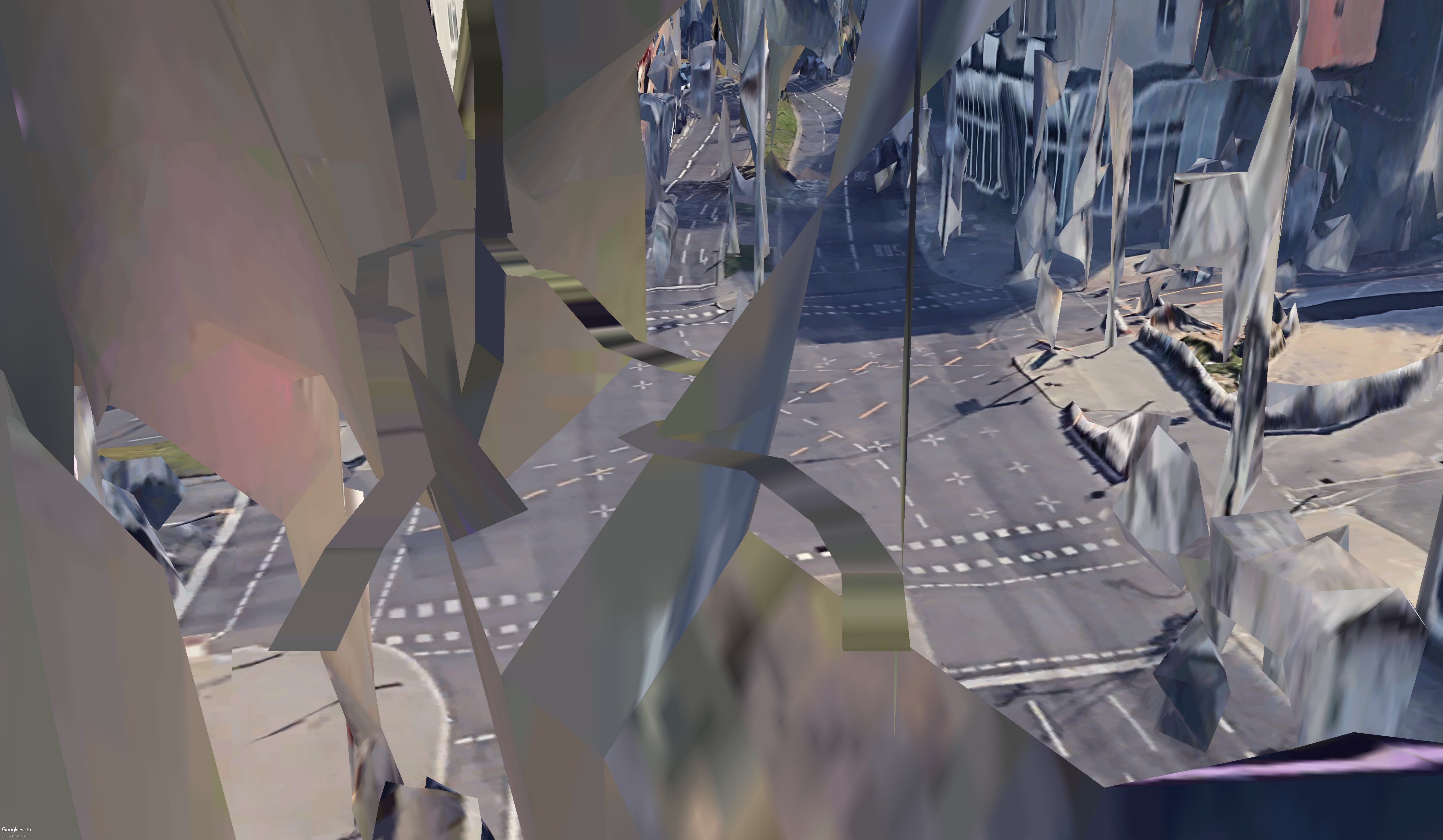
Polak van Bekkum, Daily Life at a Crossing (2019 – digital video still)
“Your ears are about 20 cm apart. How will you experience the city once you enlarge that distance? Will this make you hear like a giant?
In two afternoons participants experimented with listening over expanded distances: with your ears one meter apart, 2 meters, 5 meters, 20 meters, as if you enlarge your head. Can you intertwine sounds that enter your ears from a greater distance than you are used to?”
The artists created a system for streaming audio from smartphones to extend the distance between the microphones as far as possible. Once decided on the technical setup, participants went out to the street to ‘become’ different objects: a tree, a bridge, a car, or a bus stop.
Polak and van Bekkum are curious to radicalise the scale of this work method as far as possible. Can we even identify with a building adding one ear to one side and the other to the opposite side?
At the start of the workshop all participants were asked to introduce themselves, to see what fields of knowledge, experience, and curiosity each of them brought. During the workshop built on this collective expertise. Concluding the workshop, it was define what ‘spatial listening’ brought us.
Can we approach the urban landscape from this position with a different view, or rather a different ear? What sort of bodily information do we get? What is the role of (mobile) tech to this? What is this kind of spatial listening? And how does it affect our sense of city-awareness?
https://spektrum.community/events/detail/architecture-as-sonic-experience.html
Masterclass Archiving As Resistance, Lara Baladi, Medialab Prado, Madrid, 28-29 April 2018
In Madrid the second masterclass was developed with JARD in Madrid, guided by the Egyptian-Lebanese artist Lara Baladi. Baladi is a former fellow at MIT’s Open Documentary Lab and currently a faculty member at the MIT ACT – Art, Culture and Technology program.
Archiving As Resistance, mapped key points and questions related to archiving the Web with a focus on archiving protests related data as a means of resistance. Lara Baladi’s project, “Vox Populi, Archiving a Revolution in the Digital Age” served as a starting point to study various archives initiatives in the global context and web recording tools.
Depending on their interests and skills, the participants produced a project collaboratively based on material they had researched and gathered beforehand. The project focused on the protest actions against sexual violence against women that reached a boiling point exactly during the workshop.
A web journal was created (link and image below) that collected materials not just during the workshop but also afterwards as an ‘instant’ archive of resistance.
This workshop was open to activists, digital archivists, artists, filmmakers, developers, web designers, architects, and more.
https://www.medialab-prado.es/en/node/39130
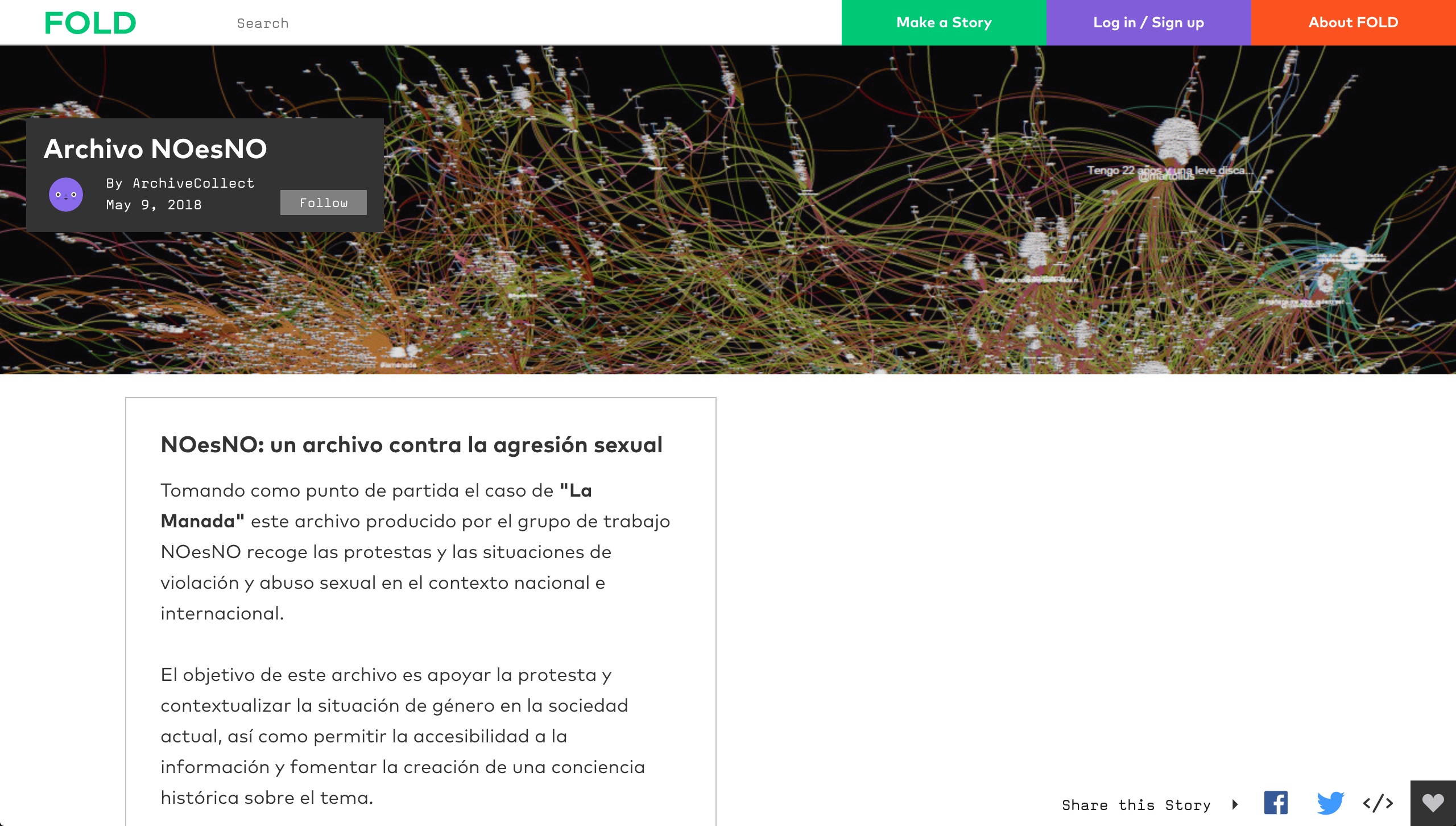
NOesNO: un archivo contra la agresión sexual (‘an archive against sexual aggression’):
https://fold.cm/read/ArchiveCollect/archivo-noesno-Lavtuu5b
Masterclass Deep Space: re-signifying Valle de los Caídos, hybrid space lab, @ Medialab Prado, Madrid, 25-27 October 2018
Also in Madrid the third masterclass “Deep Space: re-signifying Valle de los Caídos” was hosted by the Medialab Prado and JARD architecture agency. This master class was guided by Frans Vogelaar & Elizabeth Sikiaridi, co-founders of the Hybrid Space Lab, Berlin. The work of Vogelaar & Sikiaridi on Hybrid Space has been foundational for the development of the Affect Space concept and research.
Deep Space is a long-term investigative program initiated as part of the reDesigning Affect Space public research trajectory to deal with politics of memory, controversial space and monuments, digitalization and heritage. The project is on-going. The main question raised by Vogelaar and Sikiaridi for this masterclass was: How to transform and re-signify Valle de los Caídos (“Valley of the Fallen”), the Francoist monument in the Sierra de Guadarrama close to Madrid?
Valle de los Caídos with its 152-meter-tall cross visible from more than 30 kilometers away and its “basilica”, a 262-meter long crypt with a 42-meter high vault cut out of the granite mountain rock, is one of the world’s most controversial monuments.
The structure was built between 1940 and 1959 partly by the forced labor of Spanish republican political prisoners. Next to the remains of over 33.000 fallen from both sides of the conflict (that were moved there from mass graves spread all over the country), the basilica features Franco’s grave in its most prominent spot – and next to it the grave of the Falangist leader Antonio Primo de Rivera.
The basilica-crypt, piercing the granite mountain, opens to an esplanade with scenic landscape views. Access to the Valle de los Caídos monument is provided by ‘pilgrimage’-style paths and drives, which are embedded within a sophisticated large-scale landscape design in a terrain that still holds remnants of the barracks of the prisoners of war.
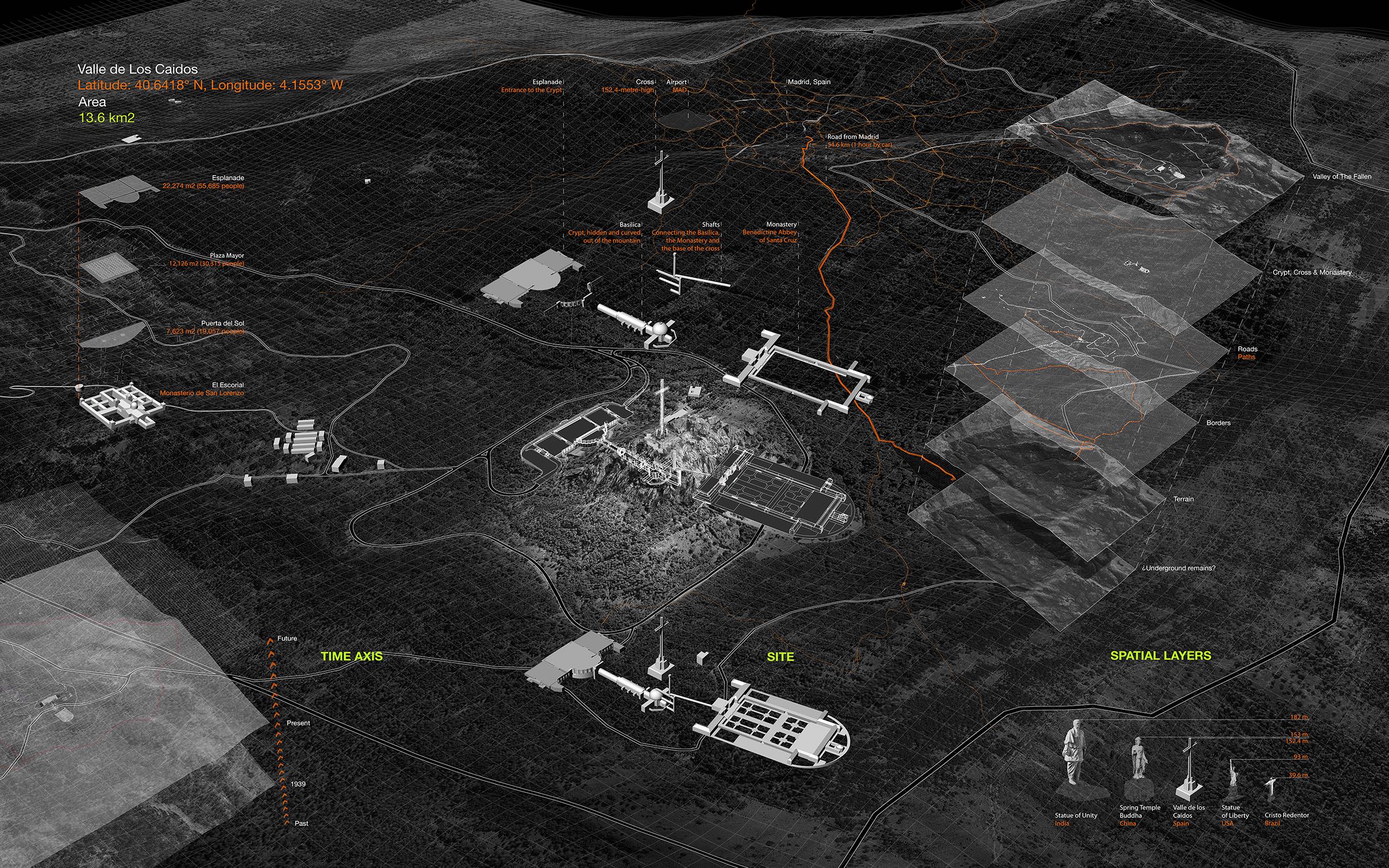
Over the past few years, there has been an intensifying discourse and controversial public debate in Spanish society and politics about the transformations needed to be pursued at Valle de los Caídos. Nevertheless there has been no artistic approach to find new possibilities and paths to transform and reinterpret Valle de los Caídos.
“Deep Space: re-signifying Valle de los Caídos” aims at developing creative processes, concepts, and ideas that can break through and transform the symbolic power of the place. The program focuses on artistic/architectural/landscape/media proposals and creative processes that develop future visions, breaking through the biased discussion.
“Deep Space: re-signifying Valle de los Caídos” derives its strength from the potential of an “outsider” approach that can bring a new perspective to a contentious and intractable situation. The workshop includes creative sessions and discussions bringing together Spanish and international creative professionals (such as architects, designers, artists, sound artists, performers, theatre-makers), theoreticians, historians, ethnologists, forensic archeologists, heritage and cultural studies experts, juridical experts, psychologists and psychoanalysts.
Questions
Complementary to the general public discussion circling mainly around the correct location for the remains of Francisco Franco and Antonio Primo de Rivera, the “Deep Space: Re-signifying Valle de los Caídos” workshop focuses on (the mostly anonymous) ‘fallen’ and on the convicted that hauled up the lumps of rock.
Who built Thebes of the seven gates?
In the books you will read the names of kings.
Did the kings haul up the lumps of rock? …
From “Fragen eines lesenden Arbeiters” (“Questions from a Worker Who Reads”) by Bertolt Brecht, 1935; translation by Michael Hamburger: Brecht, Bertolt, Poems 1913-1956, Methuen, New York/London 1976.
Tools
“Deep Space: re-signifying Valle de los Caídos” aims to develop creative tools for dealing with such a controversial monument. These tools can be of very different character and be spatial – physical, digital or hybrid (combined physical and digital). As instruments, these tools also have a strong process-related dimension.
Hybrid (combined physical and digital) technology tools offer the possibility to process the transformation of a monument without physical interference. Such tools include Augmented Reality (AR), Virtual Reality (VR), Mixed Reality (XR), and Augmented Virtuality (AV).
The workshop creates a framework where international experiences with such instruments can inform the Valle de los Caídos transformation process. At the same time, the focus on such a concrete and very actual case study as Valle de los Caídos provides the opportunity to develop insights that are of a more general relevance for dealing with monuments and heritage.
Processes
“Deep Space: re-signifying Valle de los Caídos” develops an inspirational atmosphere where creative professionals and experts reflect on a typology of creative/artistic proposals. A typology of proposed tools functions as a test environment for opening up perspectives related to the Valle de los Caídos transformation, while simultaneously helping to inform the possible direction and process for the further development of the “Deep Space” project.
hybrid space lab – Deep Space project pages:
http://hybridspacelab.net/project/deep-space
Masterclass Collective Bodies Moving in Affect Space: Are We Data?,
JARD Javier Argota & Rodrigo Delso, Het Nieuwe Instituut, Rotterdam, September 6-7, 2019
In Rotterdam a final masterclass was hosted by Het Nieuwe Instituut. This master class was guided by the founders of the JARD architecture agency in Madrid, architects Javier Argota & Rodrigo Delso. JARD presented a fascinating talk at the T / A / S workshop hosted by Het Nieuwe Instituut in May 2016, and recently contributed an audiovisual essay to the Open! platform. Of particular interest to us was the project and online platform Open Urban Television (OUT), developed by JARD with local partners (a.o. the Media Lab Prado).

‘Heat Map’ showing concentration of activity in the square in from of the cinema and along ‘invisible’ pathways.
In the masterclass JARD analysed collective movements in public space and how these can be captured using camera observation and machine learning techniques. In their words: We are data. Every step we take in public space, how long we are seated, or how long we remain in an over-crowded square, our movements become data.
CCTV and surveillance are all about personal data (a.k.a. facial recognition). It could be either a human or an algorithm looking at us, but it is mostly framed around individual information. But what about collective data? Then, are we data?
Using the latest convolutional neural networks (commonly applied to analysing visual data), the workshop used the (machinic) brain of artificial intelligence to analyse the meaning of movement in public space. With a camera installed on the roof of Rotterdam Theatre (at the Schouwburgplein) in Rotterdam, the workshop explored the meaning of our collective body in public space while interacting with it live.
Tracking pedestrian movement over time during the ‘standing still on square furniture’ intervention.
(Showing avoidance of the immobile agents as well as dancing youngsters accidentally sharing the space.)

Tracking pedestrian movement over time during the ‘standing still on square furniture’ intervention. (Showing avoidance of the immobile agents as well as dancing youngsters accidentally sharing the space.)
We captured the movement of citizens in real-time and designed a series of actions to disrupt, play and understand the power and importance of flow to understand the city, the public and the social.
The workshop was organised as both part of reDesigning Affect Space and Neuhaus, a temporary transdisciplinary academy for more-than-human knowledge at Het Nieuwe Instituut. Workshop discussions and presentations took place within the exhibition architecture of Neuhaus.

Impression from JARD masterclass @ Neuhaus / Het Nieuwe Instituut.
The screenshots above are preliminary results from the workshop showing the effect of minimal interventions in public space producing effects only visible to the artificial eye(s) observing us.
Public Presentations
reDesigning Affect Space resulted in an extensive series of public presentations that were conducted during the entire research trajectory. These presentations showed intermediate results from the masterclasses / workshops and opened them up to public scrutiny and debate. This is the principal meaning of the idea of ‘public research’, which implies that a research trajectory is conducted in the open from the very start and continuously invites participants and public feedback as the research develops – rather than conducting the research behind closed doors and only revealing the findings once conclusions have been finalised by the researchers, without insight, oversight and feedback from ‘the public’ (i.e. humans and non humans not involved in the research itself in any capacity).
Working in the open, in public, is a mode of operation that is well-known and rather usual for artists and many cultural agents (social and service design, community activism and -media, etc.). Yet, this form of public research is totally uncommon for an academic context, where results are only made public upon (peer-reviewed) academic publication – and quite often these results are then accessible only behind over-priced electronic paywalls.
This type of closed research should be forbidden in any research project that involves public funding, which includes all university research conducted in partly or in whole publicly funded institutions. This is a principal point for all of us involved in this project. It is totally self-evident to us that research should be conducted in public, open to critique and feedback and without artificial (monetary) boundaries, particularly when public funding is involved.
Chronological overview of public presentations
Presentation Architecture as Sonic Experience: Esther Polak & Ivar van Bekkum, Spektrum, Berlin, April 16, 2018
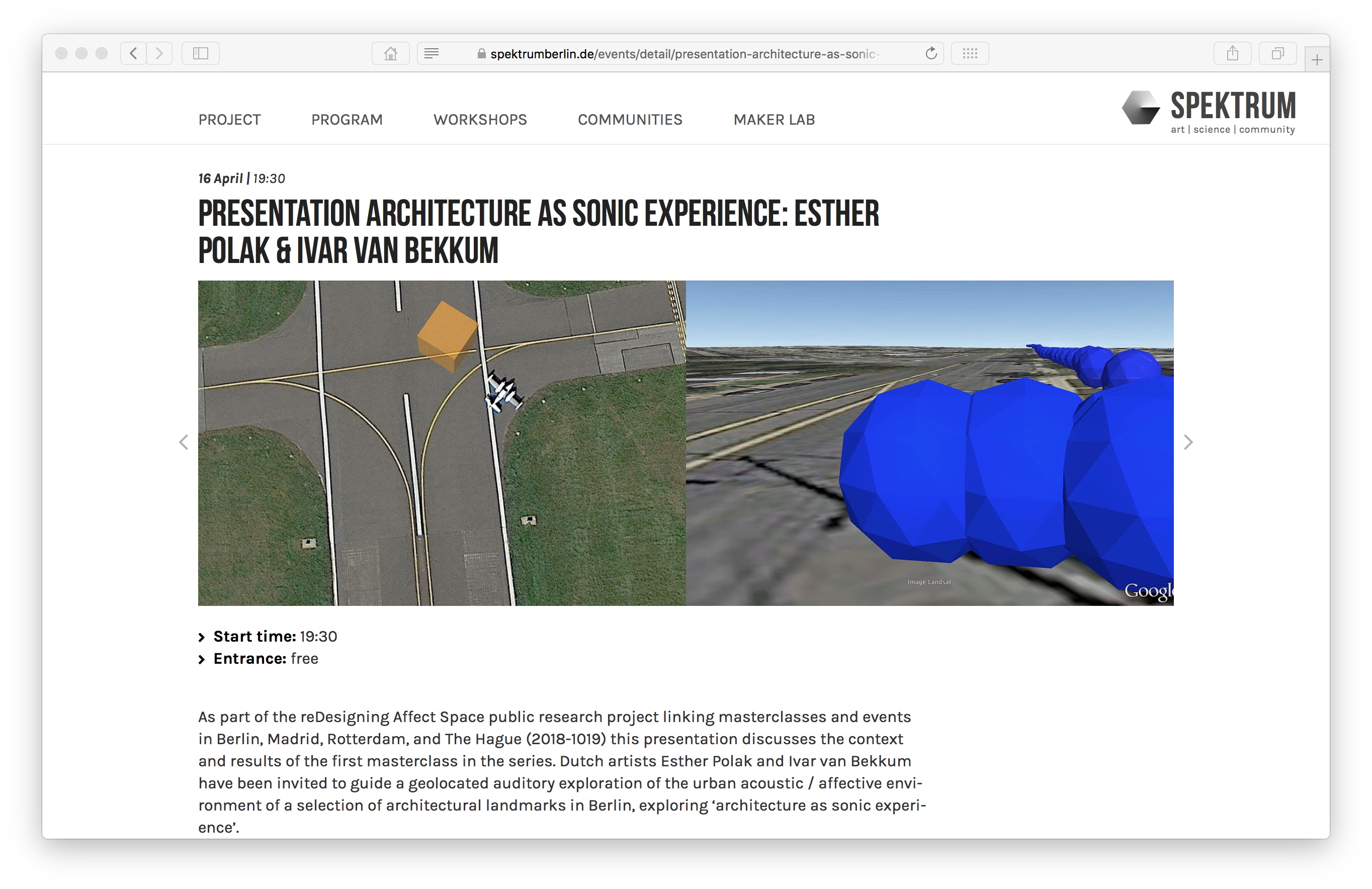
Following their workshop Architecture as Sonic Experience, also at Spektrum in Berlin, Polak and van Bekkum presented outcomes and first results. These included binaural recording experiments, capturing city sounds but extending the range of the microphones. The experiment was continued during the presentation with two ‘agents’ carrying each of the two binaural microphones in the surrounding city environment while moving in opposite directions. The recorded sounds were transmitted wirelessly and real-time to the audience space where they were reproduced on two high quality speakers.
Thus the audience could experience the radical dispersal of sound recordings by the binaural microphones that are usually placed at the distance of two human ears belonging to the same head (normally about 20 cm apart).
https://spektrum.community/events/detail/presentation-architecture-as-sonic-experience-esther-polak-ivar-van-bekkum.html
Fault Lines Symposium, KABK Design / Research, The Hague, Royal Academy of Art, December 14, 2018:
Fault Lines explored the interstitial positioning and generative potential of design research as the borders of disciplines shift, while presenting an array of research projects that map and interpret the traces of design’s complicity in climate change.
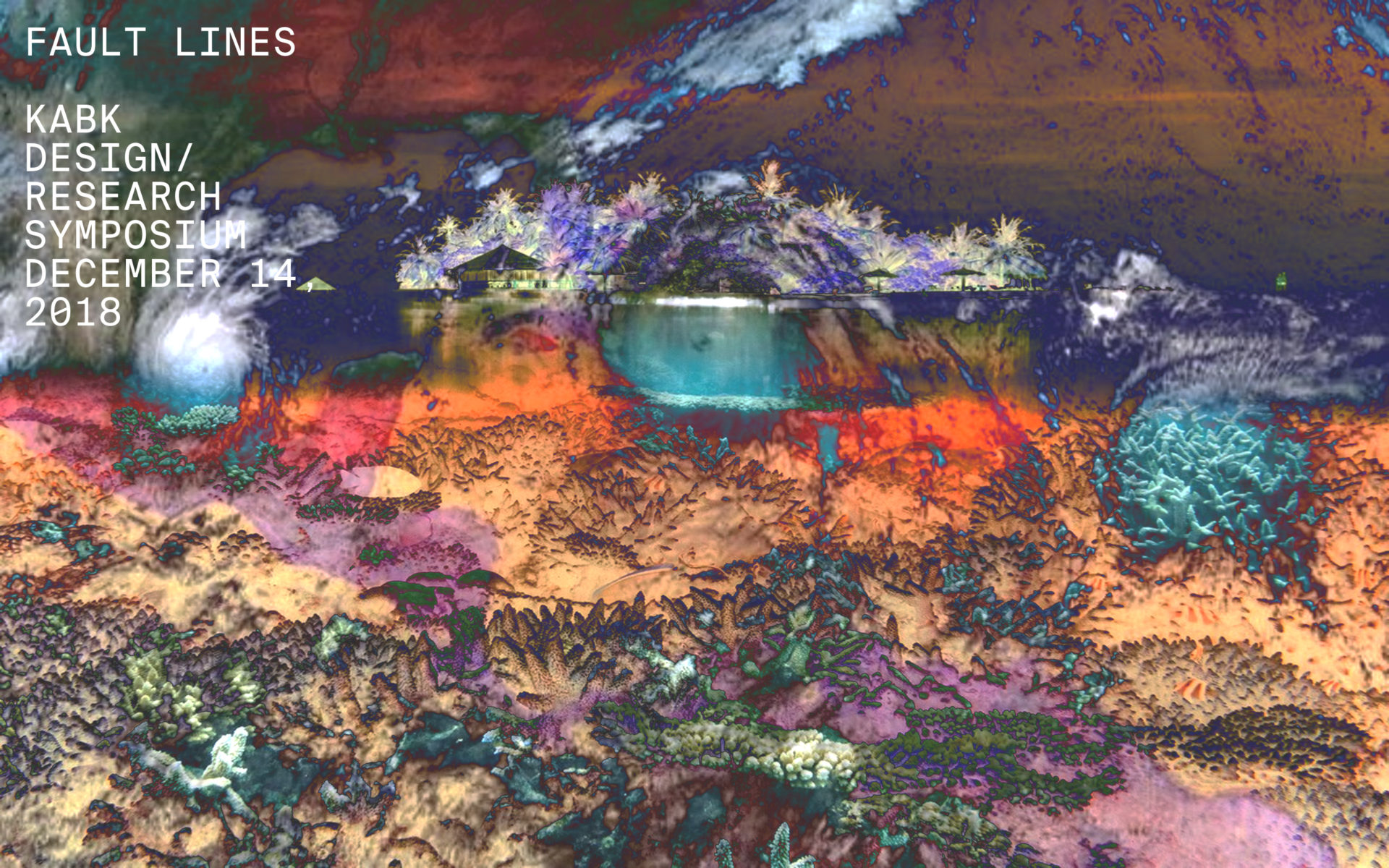
Questions asked included: How does contemporary design research inhabit the fissures between disciplinary realms and negotiate the discontinuities between them?
Are there particular qualities and capacities of design-specific tools and methods and what do they allow for?
And how can the insights that arise from experimental research inquiries make a significant contribution to design practice, to education, and to knowledge?
Eric Kluitenberg presented the intermediate findings of the reDesigning Affect Space project as part of the Design Research Group at the Royal Academy of Art in The Hague.
https://www.kabk.nl/agenda/fault-lines-design-research-at-kabk-leiden-university
Lecture / Discussion Hybrid Space Lab @ Traces conference, Politecnico di Milano School of Architecture, Milan, 25 January 2019
Hybrid Space Lab presented and discussed the Deep Space – re:signifying Valle de los Caidos project at the TRACES conference in Milan.
TRACES is a three-year project funded in 2016 by the European Commission as part of the Horizon 2020 Research and Innovation Programme. Through an innovative research methodology, TRACES investigates the challenges and opportunities raised when transmitting complex pasts and the role of difficult heritage in contemporary Europe.
http://www.traces.polimi.it
Presentation @ transmediale 2019 – reDesigning Affect Space, Berlin, Haus der Kulturen der Welt, February 3, 2019
At transmediale 2019 we focused specifically on two projects that emerged out of previous masterclasses:
Architecture as Sonic Experience, by artists Esther Polak and Ivar van Bekkum, which extended the well-known practices of binaural recording to an architectural and urban scale, listening to what buildings, streets, stations, and airports “hear” at their extreme edges.
Deep Space: Memory Politics in the Digital Age, by Hybrid Space Lab (Elizabeth Sikiaridi & Frans Vogelaar) focuses on the strongly emotionally charged memory politics of Valle de los Caídos in Spain and on the re-signification of this Francoist site—one of the world’s most controversial monuments. The Deep Space project addresses the re-signification of traditional physical monuments and heritage with the help of digital dynamic networked archives: What could future heritage (sites) look, feel, sound like, and how could their digitally enriched features affect memory-making processes?
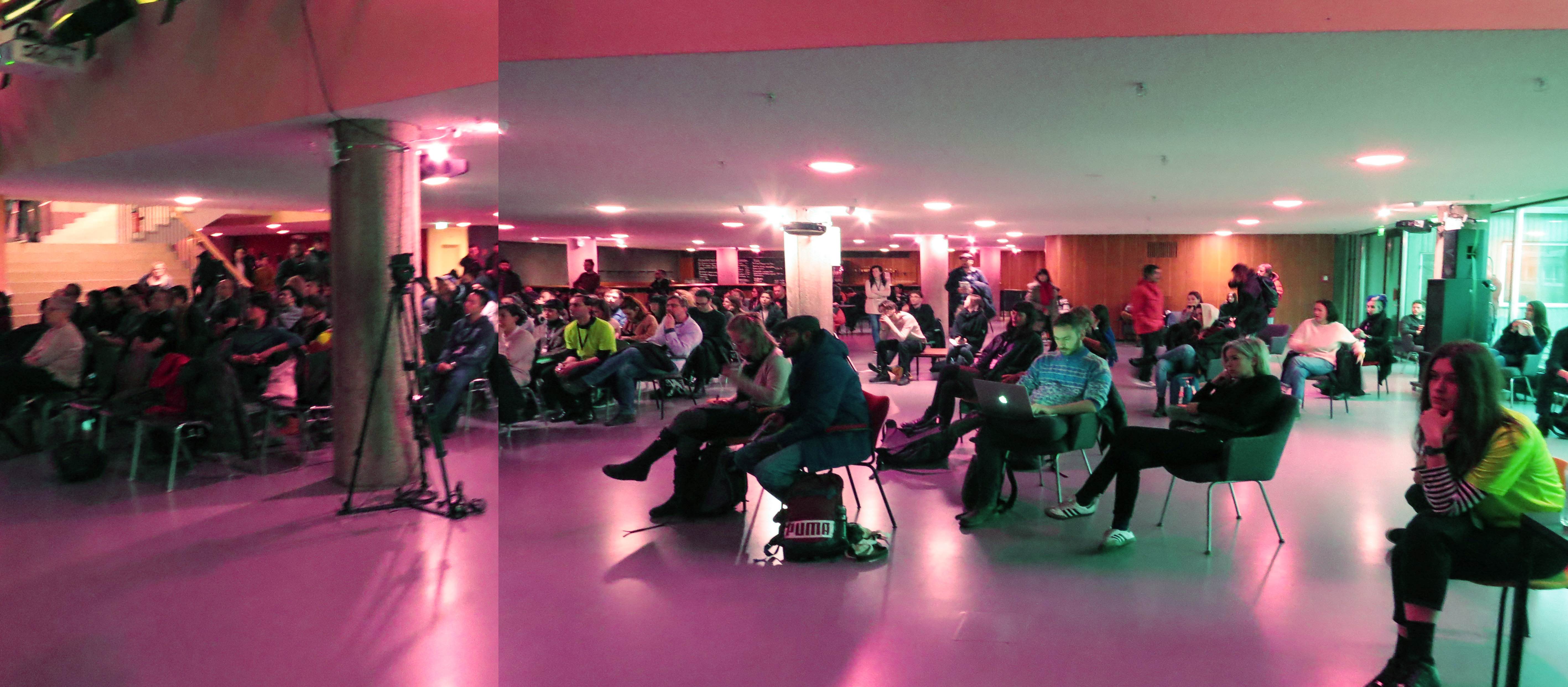
Audience view reDesigning Affect Space presentation @ transmediale
https://2019.pastwebsites.transmediale.de/content/redesigning-affect-space
Exhibition and opening discussion Deep Space: re-signifying Valle de los Caidos at the Goethe Institute, Madrid, June 5, 2019
The Goethe Institute in Madrid projected the large scale graphic of the analysis of Valle de los Caidos by Hybrid Space Lab on the facade of the institute. At the occasion of the opening of the exhibition a discussion was organised with Miquel Gonzalez, Photographer, Emilio Silva, Journalist and Prof. Gutmaro Gomez Bravo.
https://www.goethe.de/ins/es/de/ver.cfm?fuseaction=events.detail&event_id=21575494
Lecture Hybrid Space Lab on Deep Space: re-signifying Valle de los Caidos at the Nonument Symposium, Center for Advanced Media Prague (CAMP), June 13-14 2019
Nonument! is a symposium dedicated to hidden, abandoned and forgotten monuments of the 20th century. Nonument is also an ongoing research and artistic project initiated by MoTA – Museum of Transitory Art from Ljubljana Slovenia, dedicated to archiving, mapping and studying the architectural heritage, monuments and public spaces of the 20th century.
The Nonument Group, an international art collective, operates within the ambit of this platform. By staging artistic interventions, the collective calls attention to the importance of public spaces and the issues caused by nonsustainable management of architectural heritage.
Hybrid Space Lab presented their on-going work in the Deep Space: re-signifying Valle de los Caidos project.
https://nonument.org/news/nonument-symposium-prague-13-14-june-2019/
reDesigning Affect Space @ Neuhaus / Thursday Night Live, Het Nieuwe Instituut, Rotterdam, 5 september
At Thursday Night Live! program findings from the reDesigning Affect Space public research were presented at Het Nieuwe Instituut in Rotterdam.
The question explored was how Affect Space can be redesigned for a more poetic, critical, and open civic engagement, and how to include the design disciplines in shaping such alternative designs? This question also formed the starting point of the masterclass Collective Bodies Moving in Affect Space: Are We Data? by JARD (architects Javier Argota and Rodrigo Delso) that took place subsequently on 6 and 7 September at Het Nieuwe Instituut.
With an introduction by theorist Eric Kluitenberg, who coined the term Affect Space. JARD (architects Javier Argota and Rodrigo Delso) explored how bottom-up Machine Learning algorithms can be applied to urban camera observation to analyse collective movements in public space. The program also included the (world) premiere of the digital film Daily Life at a Crossing by artists Esther Polak and Ivar van Bekkum.
In their words: “This video is an experiment in the experience of space. For this video we combined the virtual visual world that is offered to us by Google Earth, with a self produced audio recording. The sound you hear is recorded of a building at the crossing of the Martin-Luther Strasse and Hohenstaufen-Strasse in Berlin. We used extended binaural recording: the right channel is the south side of the building, the left the north. At the same time a slow movement around the crossing is visible, executed in the current state of Google Earth. The two sound channels and the video are related, and not related. There is a gap, and there is a connection.”
https://neuhaus.hetnieuweinstituut.nl/en/timetable/redesigning-affect-space
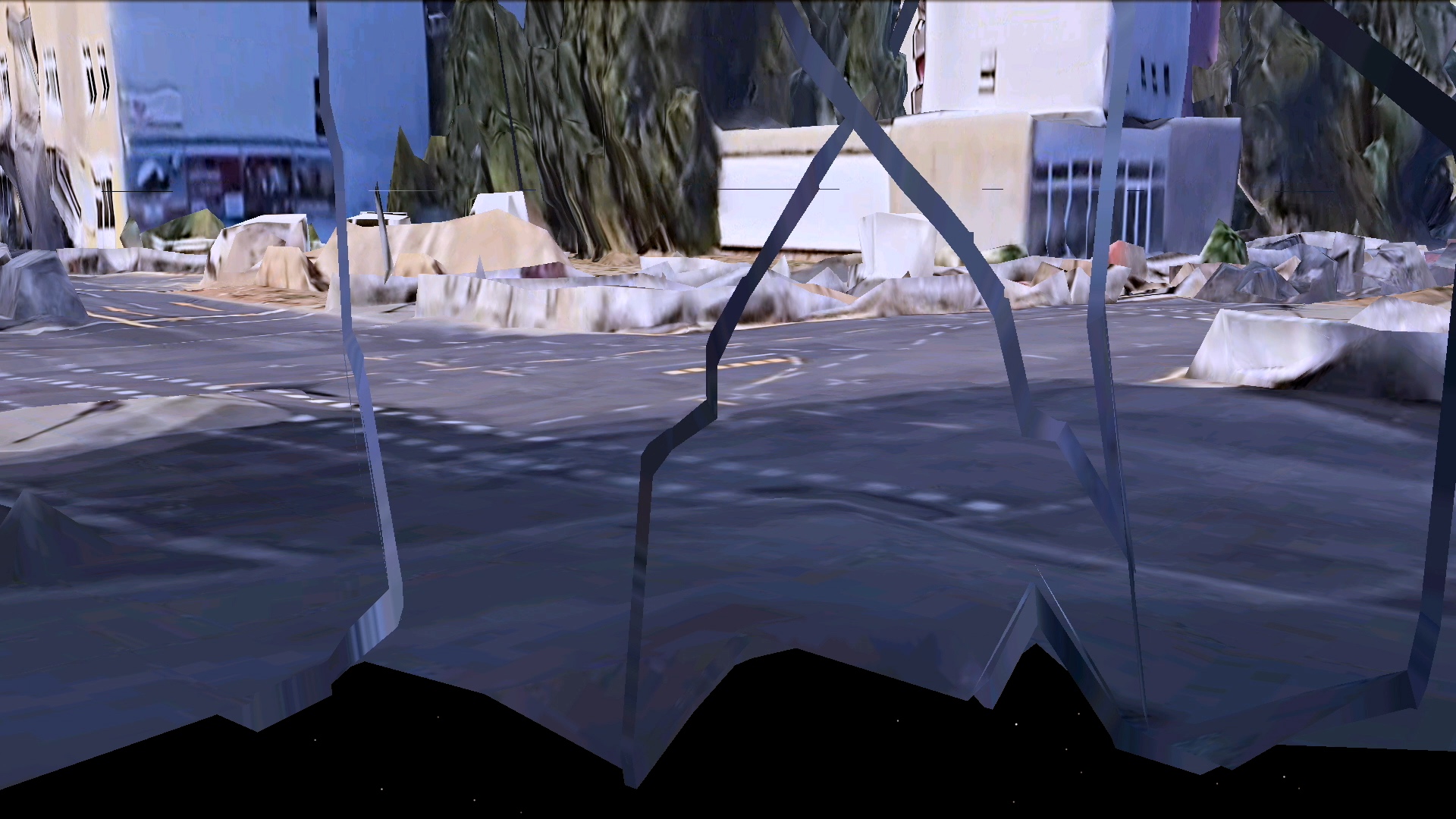
Daily Life at a Crossing (2019, still)
Polak & van Bekkum, Daily Life at a Crossing (2019) in the Neuhaus Exhibition, Het Nieuwe Instituut, Rotterdam, September 5 – 15, 2019
After the official premier in the Thursday Night Live program on September 5, 2019 the film resulting from the masterclass Architecture as Sonic Experience by Esther Polak and Ivar van Bekkum was integrated in the Neuhaus exhibition at Het Nieuwe Instituut in Rotterdam.
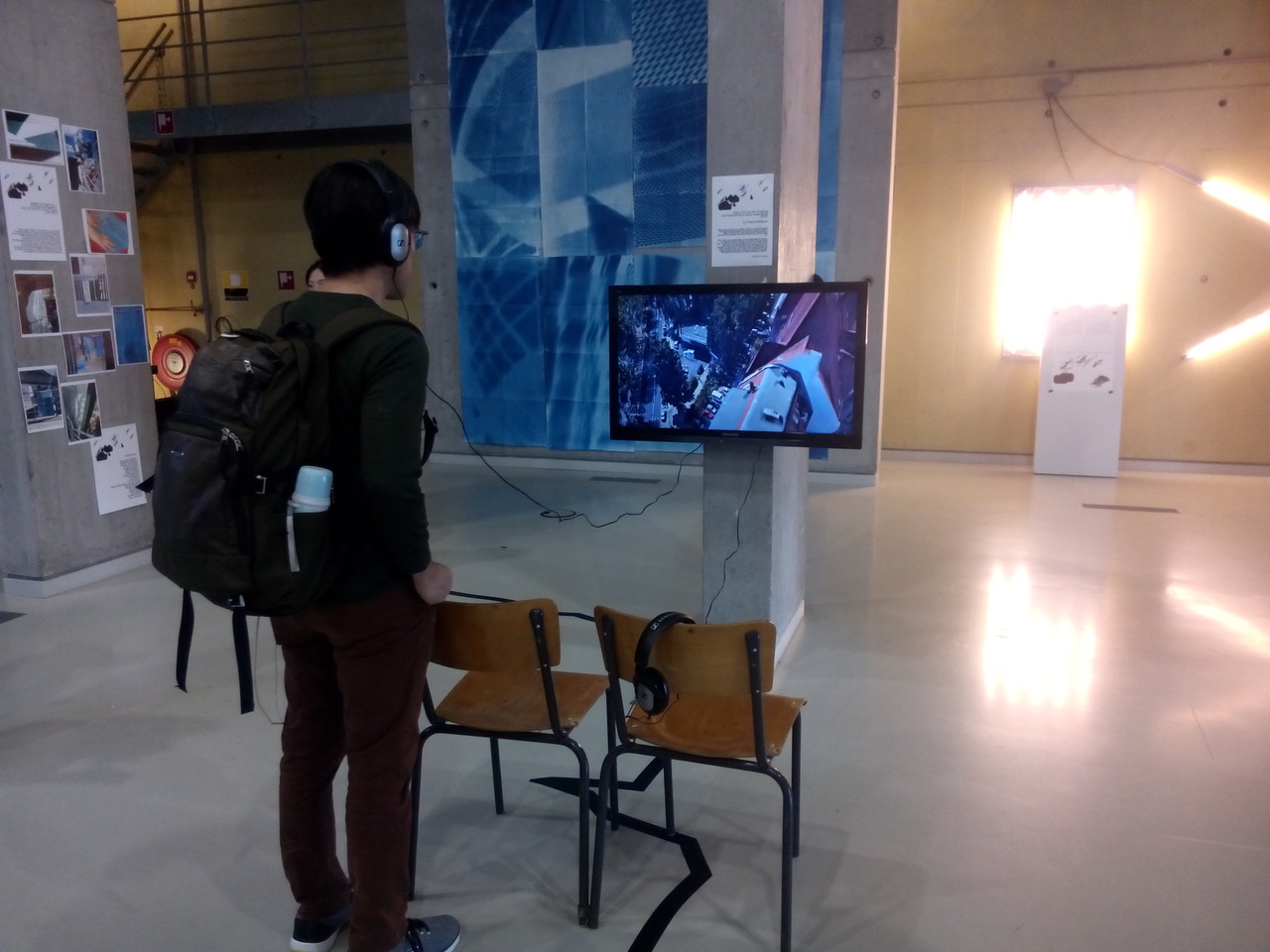
About the film: Using extended binaural recording from the north and south side of a building at the crossing of the Martin-Luther Strasse and Hohenstaufen-Strasse in Berlin, a slow movement around the crossing is visible, executed in Google Earth. The two sound channels and the video are related, and not related. There is a gap, and there is a connection.
Neuhaus @ HNI: https://neuhaus.hetnieuweinstituut.nl/en
Exhibition of the Design / Research Symposium, The Hague, Royal Academy of Art, December 6-10, 2019
The film Daily Life at a Crossing by Polak van Bekkum (2019) and the documentation of the masterclass Collective Bodies Moving in Affect Space by JARD (Madrid) will be included in the new first exhibition accompanying the annual Design / Research symposium at the Royal Academy of Art, The Hague. These will act as a practice based reflection on the research carried out in the frame of the Design Research Group throughout 2018.
Future outlook
Beyond these past and confirmed presentations the reDesigning Affect Space project continues in a prospective second Deep Space: re-signifying Valle de los Caidos workshop, currently in preparation by hybrid space lab. Furthermore, we were not able to realise a larger scale conference or public presentation in Madrid of the project as a whole. We feel that it would be worthwhile to organise a comprehensive concluding conference-type public discussion event to interrogate the possibilities and limitations of the Affect Space concept for creative and spatial design disciplines, and the specific finding in our collective projects thus far.
Mainly for economic reasons this appears not to be feasible in Madrid, which would be the logical choice given the structure of our project. One idea circulated has been to link such a larger scale gathering to an existing public festival, exhibition, or biennale to make use of existing public infrastructures and avoid redundant organisational overhead. This is an interesting idea that we will explore in the coming time, but as yet also remains exactly that – an interesting idea…
It may hardly come as a surprise that we have, in this project, not resolved the problematic absence of the spatial design disciplines in the operation and design / redesign of Affect Space. What the project did show, however, is that the three modalities of engagement identified in the preparatory research – the analytic / the political / the experiential – are possible to bring into play also for relatively small players with modest means. In this sense we understand this project first of all as an encouragement for others in the creative and design disciplines to follow suit and extend their practices beyond the obvious and the short-term profitable. Towards the academic communities we throw the gauntlet down – open up your research – don’t sit on the results until they no longer matter for us collectively moving in public space…
Online publications and resources
HNI / Neuhaus masterclass with JARD (Madrid), September 6-7:
https://neuhaus.hetnieuweinstituut.nl/en/timetable/collective-bodies-moving-affect-space-are-we-data
HNI / Neuhaus presentatie 5 september:
https://neuhaus.hetnieuweinstituut.nl/en/timetable/redesigning-affect-space
Neuhaus @ HNI:
https://neuhaus.hetnieuweinstituut.nl/en
JARD – Affect Space: After 1.097 hours watching Puerta del Sol
http://www.jard.us/affect-space
Presentation @ transmediale 2019 – reDesigning Affect Space:
https://2019.pastwebsites.transmediale.de/content/redesigning-affect-space
Fault Lines Symposium, KABK Design / Research, December 14, 2018:
https://www.kabk.nl/agenda/fault-lines-design-research-at-kabk-leiden-university
hybrid space lab – Deep Space project:
http://hybridspacelab.net/project/deep-space
Archiving As Resistance, Lara Baladi workshop in Madrid, 28 + 29 April 2018:
https://www.medialab-prado.es/en/node/39130
Masterclass Architecture as Sonic Experience, Polak & van Bekkum, Spektrum, Berlin, April 14-15
https://spektrum.community/events/detail/architecture-as-sonic-experience.html
Presentation Architecture as Sonic Experience, Polak & van Bekkum, Spektrum, Berlin, April 16, 2018.
https://spektrum.community/events/detail/presentation-architecture-as-sonic-experience-esther-polak-ivar-van-bekkum.html
Polak & van Bekkum – The City as a Performative Object – An Essay in Footsteps:
https://www.onlineopen.org/the-city-as-performative-object
Essay (Re-) Designing Affect Space @ Open!:
https://www.onlineopen.org/re-designing-affect-space
Essay Affect Space – Witnessing the Movements of the Squares @ Open!:
https://www.onlineopen.org/affect-space
Landing page Technology / Affect / Space @ Open!:
https://www.onlineopen.org/technology-affect-space
Partners
Het Nieuwe Instituut, Rotterdam
JARD, architecture agency, Madrid
Escuela Técnica Superior de Arquitectura de Madrid
Medialab Prado, Madrid
Hybrid Space Lab, Berlin
ArtScience Interfaculty, The Hague
Design / Research, KABK, The Hague
MIT ACT – Art, Culture & Technology program, Cambridge (MA)
Open! Platform for Art, Culture & the Public Domain
Stichting Cool Mediators, Amsterdam
Project-team
Eric Kluitenberg, media theorist, lead researcher / project leader.
Klaas Kuitenbrouwer, curator, theorist, Het Nieuwe Instituut, Rotterdam.
Rodrigo Delso & Javier Argota, JARD, Madrid
Elizabeth Sikiaridi & Frans Vogelaar, Hybrid Space Lab, Berlin
Alice Twemlow, research professor design, Royal Academy of Art, The Hague
Taconis Stolk, head of the ArtScience Interfaculty, The Hague
Jorinde Seijdel, chief-editor of Open! Platform for Art, Culture and the Public Domain
Co-ordination / Production
The Cool Mediators foundation acted as the overall production co-ordinator for this project. Cool Mediators is a light-weight organisation that is entirely project based and strives for minimal overhead. The foundation acts as a mediator and catalyst, developing its projects with ever changing constellations of partner organisations, with an aim to initiate and realise content-driven projects that these partner organisations would not, or can not organise by themselves.
Support
reDesigning Affect Space is financially supported by The Netherlands Creative Industries Fund, Het Nieuwe Instituut, and transmediale festival, Medialab Prado, Goethe Institute Madrid, and with further support by hybrid space lab, JARD architects, and Cool Mediators Foundation.
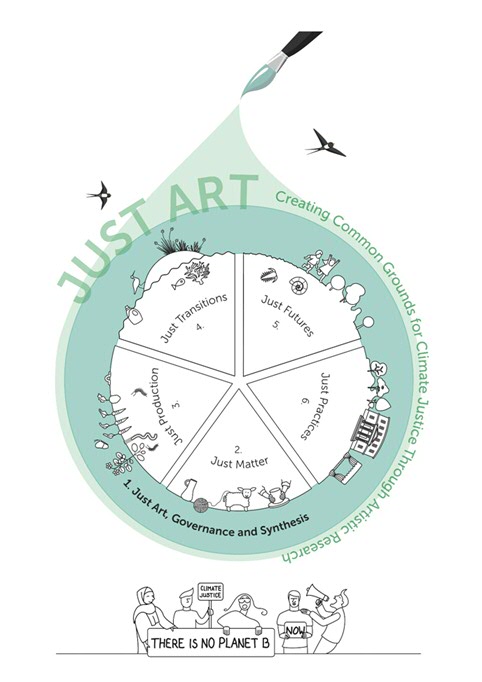 As the impacts of climate change accelerate, it is becoming increasingly clear that those least responsible for the crisis are also those most likely to be the hardest hit. This is one of the central tenets of climate justice, a framework that highlights the deep inequities and injustices shaping responses to climate change.
As the impacts of climate change accelerate, it is becoming increasingly clear that those least responsible for the crisis are also those most likely to be the hardest hit. This is one of the central tenets of climate justice, a framework that highlights the deep inequities and injustices shaping responses to climate change.


















